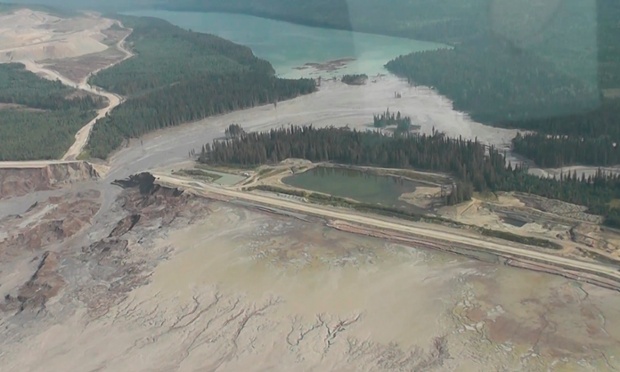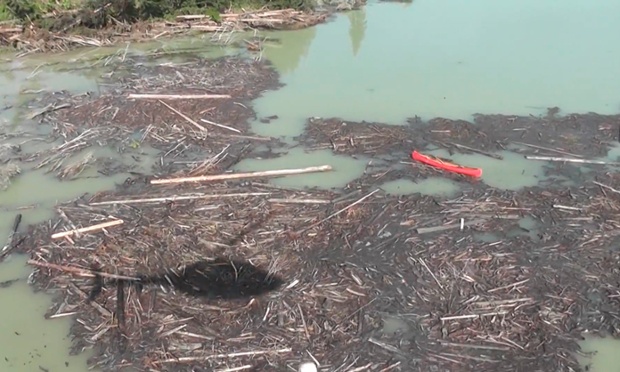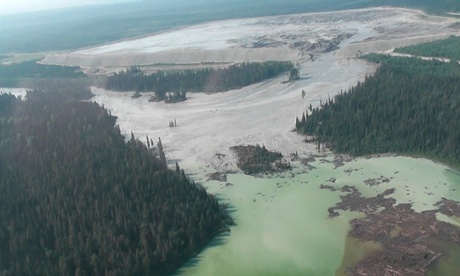The scale of the devastation only became apparent from the air. A dam at a waste pond on the site of a British Columbia open-pit mine had burst, releasing 10m cubic meters of water and 4.5m cubic meters of potentially toxic slurry into virtually untouched forest, lakes and rivers into an area of Canada populated mostly by the indigenous First Nations peoples. Soda Creek First Nations chief Bev Sellars took a helicopter tour to assess the scale of the disaster. “It looked like an avalanche, but avalanches don’t have toxic waste in them,” she said.
Government reports about the incident at the Mount Polley mine on 4 August have been cautiously optimistic, saying the surrounding water is likely safe to drink, and that wildlife will not be significantly impacted by the spill.
But the industry-friendly attitude that has become a hallmark of both the British Columbia and federal governments in Canada over the past decade has led to scepticism. Local activists and residents say they are waiting for data of their own to determine the safety of the surrounding environment. In the meantime, just over a week on from the spill, they are working to determine why it happened in the first place.
“This is a huge operation that breached because the government was negligent and the company was negligent,” said Cayoose Creek First Nations chief Michelle Edwards. “People don’t understand what this is going to do to us up here.”

The dam collapse occurred at the Imperial Metals Mount Polley gold and copper mine near the town of Likely, in the Cariboo region of British Columbia. The dam’s failure was catastrophic, allowing nearly the entire contents of the mine’s tailings pond – an area the size of New York’s Central Park holding years worth of mining waste – to flow out into Hazeltine Creek, Polley Lake and Quesnel lake.
The force of the spill widened the creek from about 1.5 meters to over 100 meters wide, according to several people who have seen the area since the spill.
“It’s basically a debris field of this toxic sludge,” said Jeremy Williams, a local activist and filmmaker who toured the damage on a boat last week. “It was easily knee deep and waist deep in some places.”
Despite the disturbing images of the area that filled Canada’s newspapers and television stations in the days after the spill, British Columbia’s government has insisted the dam failure is not an environmental disaster. The province’s minister of energy and mines also compared the flow of effluent and sludge to an avalanche, but in a positive light.
“The difference is that snow melts, [but] you are left with exactly the same [result],” Bill Bennett told the Vancouver Sun.
The initial water tests seem to back up Bennett’s claims, with samples showing mercury and other toxic substances at historical levels.
But according to experts, the full extent of the damage may remain unknown for years or even decades, as toxins from the mine slowly build up in the environment.
“Water will continue to run through literally tons of this sediment and grass will grow through the sediment,” said Brian Olding, an environmental consultant who authored a report on the Mount Polley Mine in 2011. “Imagine if a moose eats that grass, and then an aboriginal person comes and shoots that moose. Then we have a food contamination issue on our hands.”
Conflicts of interest
Local residents and critics of the British Columbia provincial government also say officials may be playing down the spill’s negative effects.
As Canada has gone all-in on resource extraction in the last decade or so, with prime minister Stephen Harper promising to turn the country into one of the largest natural resource exporters in the world, governments across the country, including in British Columbia, have developed close ties with extraction industries.
Imperial Metals and its related companies and investors have donated upwards of $200,000 to British Columbia’s ruling Liberal Party since 2005, according to campaign finance records. Imperial Metals controlling shareholder Murray Edwards also held a million-dollar fundraiser for British Columbia premier Christy Clark, according to the Vancouver Sun. Clark has also praised Edwards.
“A significant part of our progress in British Columbia comes from people like Murray Edwards,” she said in a 2012 speech at the University of Calgary, in which she extolled the virtues of mining for the BC economy.
Activists say those relationships have created a conflict of interest that may have prevented officials from taking action at the Mount Polley Mine before disaster struck.

Under Clark’s predecessor Gordon Campbell, also a Liberal Party member, the number of inspections of mines was cut in half, according to government data.
Still, BC’s environment ministry issued five notices of violation to the Polley mine since 2012, including one in May for operators allowing waste to build up past the capacity for which the tailings pond was designed. The engineering company that designed the tailings pond had also warned that it was operating potentially beyond capacity. The company pulled out of the mine operation in 2011 without saying why. Also in 2011, a report by Brian Olding, commissioned by two First Nations groups and paid for by Imperial Metals said the tailings pond was being expanded too rapidly.
It is unclear if Imperial Metals acted on any of those warnings. Requests to the company for interviews were not returned for this story.
Now, Imperial Metals will likely be on the hook for tens of millions of dollars in cleanup costs.
The company has promised to work with the British Columbia government to address the cleanup. But that’s of little comfort to those who live near the mine. Even for supporters of the company, the toll on the local towns near Mount Polley is clear.
Urszula Kucharczyk, the co-owner of Morehead Lake Cabins, a resort in Likely, said she is not too worried about the environmental impacts of the spill, but knows that her livelihood will be affected regardless. About 80% of the resort’s guests were mine workers, Kucharczyk said. Now, as the mine pulls back operations to focus on the cleanup, most of those workers have left.
“If the mine closes down, maybe people will get depressed and start drinking or doing drugs she said,” she said. “So maybe we can convert into a rehab.”

View all comments >
comments
Sign in or create your Guardian account to join the discussion.
This discussion is closed for comments.
We’re doing some maintenance right now. You can still read comments, but please come back later to add your own.
Commenting has been disabled for this account (why?)